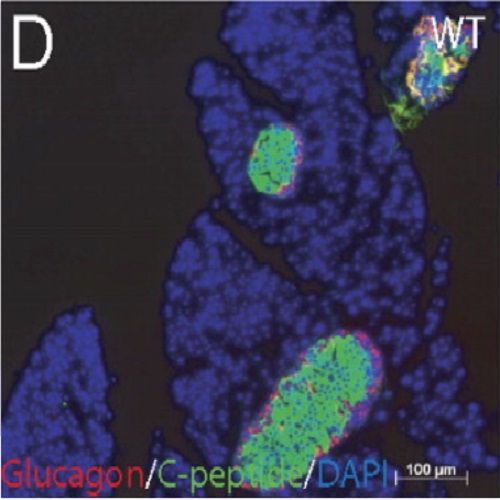Modulation of pancreatic islets-stress axis by hypothalamic releasing hormones and 11beta-hydroxysteroid dehydrogenase.
Corticotropin-releasing hormone (CRH) and growth hormone-releasing hormone (GHRH), primarily characterized as neuroregulators of the hypothalamic-pituitary-adrenal axis, directly influence tissue-specific receptor-systems for CRH and GHRH in the endocrine pancreas. Here, we demonstrate the expression of mRNA for CRH and CRH-receptor type 1 (CRHR1) and of protein for CRHR1 in rat and human pancreatic islets and rat insulinoma cells. Activation of CRHR1 and GHRH-receptor significantly increased cell proliferation and reduced cell apoptosis. CRH stimulated both cellular content and release of insulin in rat islet and insulinoma cells. At the ultrastructural level, CRHR1 stimulation revealed a more active metabolic state with enlarged mitochondria. Moreover, glucocorticoids that promote glucose production are balanced by both 11b-hydroxysteroid dehydrogenase (11?-HSD) isoforms; 11?-HSD-type-1 and 11?-HSD-type-2. We demonstrated expression of mRNA for 11?-HSD-1 and 11?-HSD-2 and protein for 11?-HSD-1 in rat and human pancreatic islets and insulinoma cells. Quantitative real-time PCR revealed that stimulation of CRHR1 and GHRH-receptor affects the metabolism of insulinoma cells by down-regulating 11?-HSD-1 and up-regulating 11?-HSD-2. The 11?-HSD enzyme activity was analyzed by measuring the production of cortisol from cortisone. Similarly, activation of CRHR1 resulted in reduced cortisol levels, indicating either decreased 11?-HSD-1 enzyme activity or increased 11?-HSD-2 enzyme activity; thus, activation of CRHR1 alters the glucocorticoid balance toward the inactive form. These data indicate that functional receptor systems for hypothalamic-releasing hormone agonists exist within the endocrine pancreas and influence synthesis of insulin and the pancreatic glucocorticoid shuttle. Agonists of CRHR1 and GHRH-receptor, therefore, may play an important role as novel therapeutic tools in the treatment of diabetes mellitus.

- Proc. Natl. Acad. Sci. U.S.A. 2011 Aug 16;108(33):13722-7
- 2011
- Medical Biology
- 21825133
- PubMed
Enabled by:
